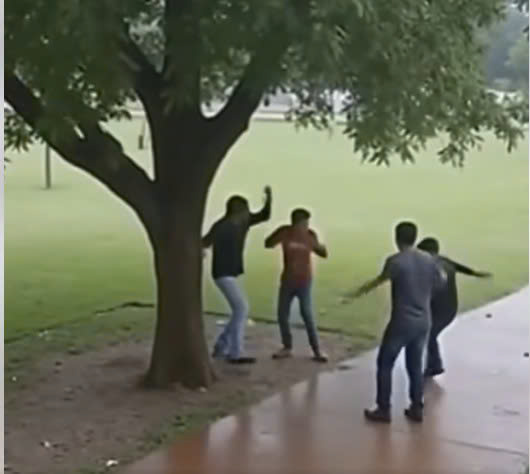What started as a calm, rainy afternoon in Gurgaon turned into a terrifying moment that stunned everyone nearby. In a matter of seconds, a bolt of lightning struck a tree where four men had taken cover from the rain. The thunderclap that followed was deafening. When it faded, silence took over—followed by frantic cries and a rush for help. The incident shocked both the local community and social media, raising not just concern for the victims but deeper questions about weather safety, climate unpredictability, and our everyday understanding of nature’s power.

According to eyewitnesses, the scene unfolded quickly and without warning. The four men had been walking in a park when the weather began to change. As the rain intensified, they did what most people instinctively do—they sought shelter under the nearest large tree. At the time, it seemed like a harmless decision. But within moments, a bolt of lightning shot down from the sky, striking the tree directly and instantly knocking all four men to the ground.
Bystanders froze in disbelief. Some people rushed forward cautiously, unsure whether it was safe to approach. Others called emergency services. The storm was still active, but the need for help outweighed the fear. Fortunately, responders arrived within minutes and transported the victims to a local hospital. Though unconscious at first, the men survived and are now in stable condition. Doctors say they are expected to make full recoveries. Medical staff and family members alike are calling it nothing short of a miracle, considering the nature and force of the strike.
Scientists explain the phenomenon clearly: lightning looks for the path of least resistance to the ground, and tall, isolated trees are often prime targets. Unfortunately, people standing beneath those trees can become part of the electrical pathway. It’s a fact many overlook, even in areas where thunderstorms are frequent. The Gurgaon incident is now being widely shared as a painful but important reminder.
Yet while experts focused on safety, others in the community began to ask more speculative questions. Some local residents have observed increasingly erratic weather patterns over the past several weeks—strong winds, sudden cloud formations, unseasonal storms, and even electrical disturbances in nearby buildings. Though there’s no scientific confirmation of anything unusual beyond the lightning strike itself, these observations have sparked conversation. Could this be a sign of shifting climate dynamics? Is the environment changing in ways we don’t fully understand yet?
While these questions remain open, one thing is certain: weather awareness is more important than ever. Experts from the Indian Meteorological Department issued fresh advisories immediately after the incident, warning the public to avoid open fields, tall structures, and especially trees during electrical storms. They’ve urged citizens to take shelter in enclosed spaces and remain indoors until the storm fully passes. Their message is simple—don’t gamble with weather, no matter how familiar or routine it may seem.
The park where the strike happened remains open, but the atmosphere is different now. Locals pass the tree quietly, some offering glances of respect or concern. Parents have started warning their children about where to go during sudden rainstorms. Joggers, who once took shelter under that very tree during drizzle, now choose to head home early at the first sign of thunder. The incident has changed not only behavior but perception—what was once just another tree in the park now stands as a symbol of how quickly conditions can change.
There’s also growing recognition of the thin line between safety and danger when it comes to natural forces. In cities like Gurgaon, where rapid urban development continues alongside unpredictable weather patterns, the need for public safety education is critical. Not everyone knows what to do during a thunderstorm. Not everyone knows that lightning doesn’t have to strike directly to be dangerous—it can travel through roots, metal fences, even wet ground. This awareness could save lives.
Fortunately, in this case, lives were spared. The four men are expected to recover fully, though they remain under observation. Friends and family have expressed gratitude for the quick medical response and for the strangers who helped without hesitation. Their survival serves as a powerful example of resilience and luck—but also as a warning.
It’s easy to underestimate the power of nature when we live surrounded by buildings, technology, and routine. But storms don’t follow convenience. They don’t wait for you to find proper shelter. That’s why preparation and understanding matter. This lightning strike wasn’t just an isolated weather event—it was a wake-up call for everyone in the city, and perhaps beyond.
As the monsoon season continues, residents are being urged to monitor weather updates more closely. Apps, radio alerts, and public service announcements can provide crucial information before storms escalate. Schools and workplaces are being encouraged to update their emergency procedures and to educate staff and students about outdoor safety during storms.
What happened in that Gurgaon park was sudden, frightening, and very real. But it doesn’t have to happen again. By taking the right precautions—avoiding risky shelter, understanding storm behavior, and spreading awareness—we can minimize the danger. The key takeaway is simple: when skies darken and thunder rumbles, take it seriously. Nature’s power is real, and it deserves our respect.
Let this be a lesson shared widely, not out of fear, but out of wisdom. The lives spared that day are a blessing. But they also come with responsibility—to act smarter, to stay safer, and to never take for granted how quickly a calm day can turn into a storm.





